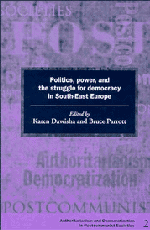Book contents
- Frontmatter
- Contents
- List of tables
- List of figures
- List of contributors
- Preface
- 1 Perspectives on postcommunist democratization
- 2 Democratization and political participation: research concepts and methodologies
- The former Yugoslavia
- Albania, Bulgaria, and Romania
- 8 The process of democratization in Albania
- 9 Democratization and political participation in ‘postcommunist’ Bulgaria
- 10 Romanian exceptionalism? Democracy, ethnocracy, and uncertain pluralism in post-Ceauşescu Romania
- Appendix
- Index
8 - The process of democratization in Albania
Published online by Cambridge University Press: 01 June 2011
- Frontmatter
- Contents
- List of tables
- List of figures
- List of contributors
- Preface
- 1 Perspectives on postcommunist democratization
- 2 Democratization and political participation: research concepts and methodologies
- The former Yugoslavia
- Albania, Bulgaria, and Romania
- 8 The process of democratization in Albania
- 9 Democratization and political participation in ‘postcommunist’ Bulgaria
- 10 Romanian exceptionalism? Democracy, ethnocracy, and uncertain pluralism in post-Ceauşescu Romania
- Appendix
- Index
Summary
Introduction
Although Albania was the last of the East European Communist Party states to embark on the process of transition from political monism to democratic pluralism and from a centralized planned economy to a market economy, it has registered considerable progress in both areas since December 1990, when President Ramiz Alia acceded to the demands of student demonstrators at the University of Tirana for the establishment of a multiparty political system. Not surprisingly, the absence of a democratic political tradition; the fact that it is Europe's least developed state; the legacy of some four decades of domestic oppression coupled with the enforced isolation from much of the world during the unremittingly Stalinist regime of Enver Hoxha; and the vicissitudes in Tirana's relations with its neighbors in the context of the resurgent nationalism and political instability that have emerged in the Balkans during the postcommunist era have contributed to the tensions and periodic crises that have attended Albania's efforts to effect a democratic transition.
Albania's success between 1991 and 1996 in meeting the challenges arising from its precommunist and communist-era heritage owes much to the economic recovery the country has experienced since 1993; the generally strong and persistent popular sentiment for democratic reforms; the material and moral support of the United States, Western Europe, and a host of international agencies; and the charismatic leadership of the country's first non-communist president, Sali Berisha.
- Type
- Chapter
- Information
- Publisher: Cambridge University PressPrint publication year: 1997
- 5
- Cited by



